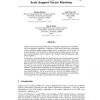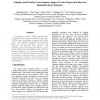118
click to vote
ICASSP
2011
IEEE
14 years 4 months ago
2011
IEEE
This study focuses on determining a procedure to select effective negative examples for development of improved Support Vector Machine (SVM) based speaker recognition. Selection o...
131
Voted
TR
2010
14 years 7 months ago
2010
This paper investigates the use of a one-class support vector machine algorithm to detect the onset of system anomalies, and trend output classification probabilities, as a way to ...
117
click to vote
IJBRA
2010
14 years 9 months ago
2010
This paper explores the scalability issues associated with solving the Named Entity Recognition (NER) problem using Support Vector Machines (SVM) and high-dimensional features and ...
142
click to vote
ICTAI
2010
IEEE
14 years 10 months ago
2010
IEEE
Recent work in the field of machine translation (MT) evaluation suggests that sentence level evaluation based on machine learning (ML) can outperform the standard metrics such as B...
114
click to vote
IJPRAI
2010
14 years 10 months ago
2010
: AUC-SVM directly maximizes the area under the ROC curve (AUC) through minimizing its hinge loss relaxation, and the decision function is determined by those support vector sample...
106
click to vote
TIP
2008
15 years 3 days ago
2008
In this paper, a novel method for reducing the runtime complexity of a support vector machine classifier is presented. The new training algorithm is fast and simple. This is achiev...
91
Voted
PRL
2006
15 years 3 days ago
2006
In the conventional incremental training of support vector machines, candidates for support vectors tend to be deleted if the separating hyperplane rotates as the training data ar...
108
click to vote
JMLR
2008
15 years 5 days ago
2008
This paper develops bounds on out-of-sample error rates for support vector machines (SVMs). The bounds are based on the numbers of support vectors in the SVMs rather than on VC di...
118
Voted
CORR
2008
Springer
15 years 8 days ago
2008
Springer
Support vector machines (SVMs) are an extremely successful type of classification and regression algorithms. Building an SVM entails solving a constrained convex quadratic program...
112
click to vote
GRC
2008
IEEE
15 years 1 months ago
2008
IEEE
An adaptive and iterative LSSVR algorithm based on quadratic Renyi entropy is presented in this paper. LS-SVM loses the sparseness of support vector which is one of the important ...



